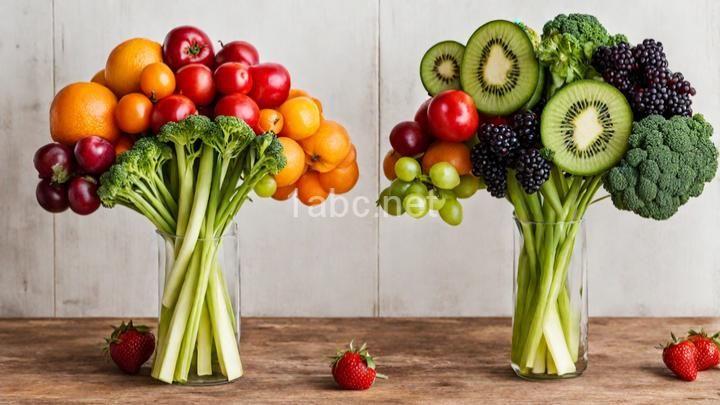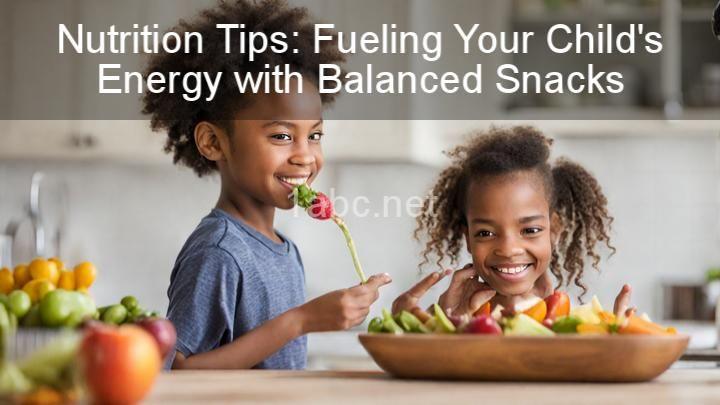Creative Ways to Make Fruits and Veggies Fun for Kids

Introduction:
Welcome to a world of delicious and exciting ways to make fruits and veggies fun for your little ones! We all know how challenging it can be to get kids to eat their fruits and vegetables. But fear not, because we're here to help you turn healthy eating into a joyful adventure! In this blog post, we will explore various creative ideas that will not only make fruits and veggies more appealing to your kids but also encourage them to develop a love for nutritious foods.
Why is it important to incorporate fruits and vegetables into kids' diets? Well, fruits and vegetables are packed with essential vitamins, minerals, and fiber that are crucial for your child's growth and development. By introducing a wide variety of fruits and vegetables early on, you're setting the stage for a lifetime of healthy eating habits. Plus, getting your little ones excited about fruits and veggies can be a family bonding experience filled with joy and creativity.
Section 1: Getting Kids Involved in Food Preparation
One of the best ways to get your kids excited about fruits and vegetables is to involve them in the food preparation process. Take your little ones grocery shopping with you and let them choose their own produce. This not only empowers them but also sparks their curiosity about different fruits and vegetables. When children feel a sense of ownership over their food choices, they are more likely to try new things.
In addition, involving kids in meal preparation has numerous benefits. It helps them develop important life skills such as measuring, pouring, and stirring. It also exposes them to different tastes and textures, making them more open to trying new foods. Start with simple tasks like washing fruits or stirring veggie-filled recipes. As they gain confidence, you can gradually give them more responsibilities in the kitchen.
Section 2: Fun with Colors and Shapes
We all know that kids are drawn to vibrant colors, so why not use that to our advantage when it comes to fruits and vegetables? Get creative with colors and shapes to make healthy eating more exciting for your little ones. Create colorful fruit and veggie skewers by alternating different fruits and vegetables on a skewer. You can also arrange them into fun shapes like animals or flowers on a plate.
Presentation is key when it comes to piquing kids' curiosity. Cut fruits and vegetables into interesting shapes using cookie cutters. For example, turn cucumber slices into stars or watermelon into hearts. You can even make a fruit salad in the shape of a rainbow using different colored fruits. The possibilities are endless, and the more visually appealing the food looks, the more likely your kids will be willing to give it a try.
Section 3: Get Creative with Snacks
Snacks are the perfect opportunity to sneak in some extra fruits and vegetables into your child's diet. Instead of reaching for processed snacks, explore unique and fun snack ideas that incorporate fruits and vegetables. For example, you can make banana sushi rolls by spreading peanut butter on a tortilla, placing a banana on top, and rolling it up. Slice the roll into bite-sized pieces, and voila! A fun and healthy snack.
Cucumber boats filled with cream cheese are another crowd-pleaser. Simply cut a cucumber in half lengthwise, scoop out the seeds, and fill the hollowed-out portion with cream cheese. You can also add other veggies like carrots or bell peppers for added crunch. These snack ideas are not only delicious, but they also provide an opportunity for your kids to get creative in the kitchen.
In addition to these snack ideas, provide your child with simple recipes that they can help prepare. Homemade fruit popsicles are a hit with kids and are incredibly easy to make. Blend together your child's favorite fruits, pour the mixture into popsicle molds, and freeze. You can also make veggie-packed smoothies by blending fruits like bananas or berries with spinach or kale. The sweetness of the fruits masks the taste of the vegetables, making it an enjoyable and nutritious treat.
Section 4: Playful Mealtime Experiences
Mealtime doesn't have to be a battle. In fact, it can be a playful and imaginative experience for your child. Introduce the concept of "food art" where kids can use their imagination to create edible masterpieces on their plates. Encourage your child to make faces or animals using different fruits, veggies, and other healthy ingredients.
For example, you can use sliced strawberries for the eyes, a banana for the nose, and blueberries for the mouth to create a fruity face on a plate. Or arrange slices of different colored bell peppers to create a vibrant flower. The key is to let your child's creativity run wild and allow them to express themselves through food.
Creating a positive and enjoyable mealtime environment is crucial for fostering a healthy relationship with food. Make mealtime a family affair by involving everyone in the process. Turn off the TV, put away electronic devices, and have meaningful conversations around the table. Create a relaxed and welcoming atmosphere where your child feels comfortable exploring new foods and flavors.
Conclusion:
In conclusion, making fruits and veggies fun for kids is not only beneficial for their health but also for their overall well-being. By implementing the creative ideas we've discussed in this blog post, you can help your child develop a love for nutritious foods that will last a lifetime. Remember, the key is to engage your child's curiosity and make healthy eating a fun experience. So go ahead, get creative, and enjoy these exciting ways to make fruits and veggies a delicious part of your child's life! Happy cooking!
FREQUENTLY ASKED QUESTIONS
What is Creative Ways to Make Fruits and Veggies Fun for Kids?
Making fruits and veggies fun for kids can be a creative and exciting challenge! Here are some creative ways to do just that:
-
Fruit and Veggie Art: Encourage your kids to get artsy with their fruits and veggies. They can create fun and colorful fruit skewers or make cute vegetable animals on their plates. This not only makes eating healthy more enjoyable, but it also sparks their creativity.
-
Smoothie Adventures: Turn healthy fruits and veggies into delicious smoothies. Let your kids choose their favorite ingredients and blend them together. You can even give the smoothies fun names like "Superhero Smoothie" or "Rainbow Blast" to make them even more enticing.
-
Veggie Dips and Sauces: Kids love dipping their food, so why not make some tasty and healthy dips and sauces for their fruits and veggies? Hummus, yogurt-based dips, or homemade salsa can make eating veggies more exciting and flavorful.
-
Food Faces: Create funny faces or characters using sliced fruits and veggies on a plate. Let your kids play with their food and make their own unique creations. This not only makes eating more fun but also encourages them to explore different flavors and textures.
-
Garden Adventures: If possible, involve your kids in growing their own fruits and veggies. This hands-on experience will make them more excited about eating what they have grown. They will feel a sense of pride and accomplishment, and it will also teach them about the importance of fresh and healthy foods.
Remember, the key is to make fruits and veggies enjoyable and appealing to your kids. Get creative, involve them in the process, and make it a fun and positive experience. By doing so, you'll be instilling healthy eating habits that will last a lifetime. Happy experimenting!
Why is it important for kids to eat fruits and vegetables?
It is important for kids to eat fruits and vegetables for several reasons. First and foremost, these nutrient-packed foods provide essential vitamins and minerals that are crucial for their growth and development. Fruits and vegetables contain antioxidants, fiber, and other compounds that support a healthy immune system and help protect against diseases.Additionally, incorporating fruits and vegetables into a child's diet can help establish healthy eating habits early on. By introducing a variety of colorful and flavorful produce, children are more likely to develop a taste for these foods and continue to choose them as they grow older. This can contribute to maintaining a balanced diet and reducing the risk of obesity and other health issues.
Fruits and vegetables also play a vital role in maintaining a healthy weight. They are low in calories and high in fiber, which can help kids feel satisfied and prevent overeating. By filling up on these nutritious foods, children are less likely to consume excessive amounts of unhealthy snacks and sugary beverages.
Moreover, fruits and vegetables promote good digestion and contribute to overall gut health. Their fiber content aids in regulating bowel movements and preventing constipation. This can be particularly beneficial for children who may struggle with digestive issues.
Lastly, incorporating fruits and vegetables into meals and snacks can add variety and flavor to a child's diet. By experimenting with different types of produce, kids can discover new tastes and textures, making eating a fun and enjoyable experience.
In conclusion, it is crucial for kids to eat fruits and vegetables due to their abundance of essential nutrients, role in establishing healthy eating habits, contribution to maintaining a healthy weight, promotion of good digestion, and ability to add variety and flavor to meals. Encouraging children to consume these colorful and nutritious foods from a young age sets them up for a lifetime of good health.
How can I make fruits and veggies more appealing to my kids?
Making fruits and veggies more appealing to kids can be a fun and creative process. Here are some ideas to make them more enticing for your little ones:
-
Presentation is key: Cut fruits and veggies into fun shapes or arrange them into colorful patterns on a plate. Kids are more likely to try something that looks visually appealing.
-
Get them involved: Let your kids help with the preparation. They can wash the fruits or veggies, pick out their favorites at the grocery store, or even help with simple tasks like tearing lettuce or stirring a salad. When they have a hand in the process, they feel more invested and are more likely to give it a try.
-
Make it a game: Turn eating fruits and veggies into a game. Create a "rainbow challenge" where they try to eat fruits and veggies of different colors each day. You can also have a taste test where they guess different fruits or veggies blindfolded.
-
Sneak them in: Sneak fruits and veggies into other dishes. For example, you can blend spinach into a smoothie, grate zucchini into pasta sauce, or add pureed sweet potatoes to muffins. This way, they won't even realize they're eating something healthy.
-
Offer variety: Don't be afraid to introduce new fruits and veggies regularly. Kids might be more willing to try something new if it's presented alongside their familiar favorites. Encourage them to try at least one bite, and if they don't like it, that's okay. It may take several attempts before they develop a taste for it.
Remember, it's important to be patient and not force your kids to eat fruits and veggies. It's all about creating a positive and enjoyable experience around healthy eating.
Are the recipes and ideas suitable for picky eaters?
Yes, our recipes and ideas are definitely suitable for picky eaters! We understand that everyone has different taste preferences, and we strive to provide a wide range of options that cater to various dietary needs and picky palates. Whether you're looking for kid-friendly meals or dishes that are more adult-oriented, we've got you covered. Our recipes are designed to be flexible, allowing you to customize them to your liking by substituting or omitting ingredients as needed. So, rest assured that even the pickiest eaters can find something they'll enjoy from our collection of recipes and ideas.



